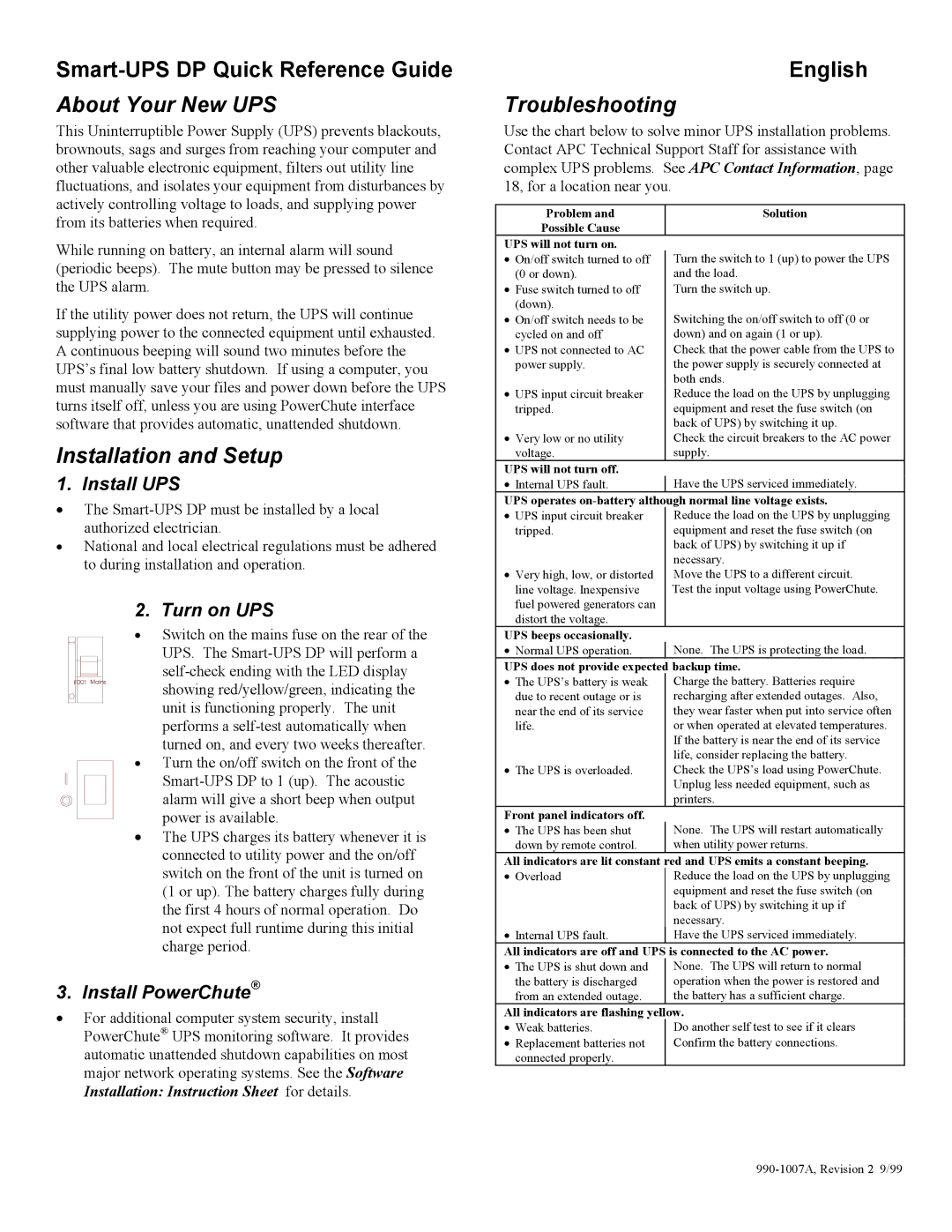About Your New UPS
This Uninterruptible Power Supply (UPS) prevents blackouts, brownouts, sags and surges from reaching your computer and other valuable electronic equipment, filters out utility line fluctuations, and isolates your equipment from disturbances by actively controlling voltage to loads, and supplying power from its batteries when required.
While running on battery, an internal alarm will sound (periodic beeps). The mute button may be pressed to silence the UPS alarm.
If the utility power does not return, the UPS will continue supplying power to the connected equipment until exhausted. A continuous beeping will sound two minutes before the UPS’s final low battery shutdown. If using a computer, you must manually save your files and power down before the UPS turns itself off, unless you are using PowerChute interface software that provides automatic, unattended shutdown.
Installation and Setup
1. Install UPS
•The
•National and local electrical regulations must be adhered to during installation and operation.
2. Turn on UPS
•Switch on the mains fuse on the rear of the UPS. The
•Turn the on/off switch on the front of the
•The UPS charges its battery whenever it is connected to utility power and the on/off switch on the front of the unit is turned on (1 or up). The battery charges fully during the first 4 hours of normal operation. Do not expect full runtime during this initial charge period.
3.Install PowerChute®
•For additional computer system security, install PowerChute® UPS monitoring software. It provides automatic unattended shutdown capabilities on most major network operating systems. See the Software Installation: Instruction Sheet for details.
English
Troubleshooting
Use the chart below to solve minor UPS installation problems. Contact APC Technical Support Staff for assistance with complex UPS problems. See APC Contact Information, page 18, for a location near you.
Problem and | Solution |
Possible Cause |
|
UPS will not turn on. | Turn the switch to 1 (up) to power the UPS |
• On/off switch turned to off | |
(0 or down). | and the load. |
• Fuse switch turned to off | Turn the switch up. |
(down). | Switching the on/off switch to off (0 or |
• On/off switch needs to be | |
cycled on and off | down) and on again (1 or up). |
• UPS not connected to AC | Check that the power cable from the UPS to |
power supply. | the power supply is securely connected at |
| both ends. |
• UPS input circuit breaker | Reduce the load on the UPS by unplugging |
tripped. | equipment and reset the fuse switch (on |
| back of UPS) by switching it up. |
• Very low or no utility | Check the circuit breakers to the AC power |
voltage. | supply. |
UPS will not turn off. | Have the UPS serviced immediately. |
• Internal UPS fault. | |
UPS operates | |
• UPS input circuit breaker | Reduce the load on the UPS by unplugging |
tripped. | equipment and reset the fuse switch (on |
| back of UPS) by switching it up if |
| necessary. |
• Very high, low, or distorted | Move the UPS to a different circuit. |
line voltage. Inexpensive | Test the input voltage using PowerChute. |
fuel powered generators can |
|
distort the voltage. |
|
UPS beeps occasionally. | None. The UPS is protecting the load. |
• Normal UPS operation. | |
UPS does not provide expected | backup time. |
• The UPS’s battery is weak | Charge the battery. Batteries require |
due to recent outage or is | recharging after extended outages. Also, |
near the end of its service | they wear faster when put into service often |
life. | or when operated at elevated temperatures. |
| If the battery is near the end of its service |
| life, consider replacing the battery. |
• The UPS is overloaded. | Check the UPS’s load using PowerChute. |
| Unplug less needed equipment, such as |
| printers. |
Front panel indicators off. | None. The UPS will restart automatically |
• The UPS has been shut | |
down by remote control. | when utility power returns. |
All indicators are lit constant | red and UPS emits a constant beeping. |
• Overload | Reduce the load on the UPS by unplugging |
| equipment and reset the fuse switch (on |
| back of UPS) by switching it up if |
| necessary. |
• Internal UPS fault. | Have the UPS serviced immediately. |
All indicators are off and UPS | is connected to the AC power. |
• The UPS is shut down and | None. The UPS will return to normal |
the battery is discharged | operation when the power is restored and |
from an extended outage. | the battery has a sufficient charge. |
All indicators are flashing yellow. | |
• Weak batteries. | Do another self test to see if it clears |
• Replacement batteries not | Confirm the battery connections. |
connected properly. |
|
